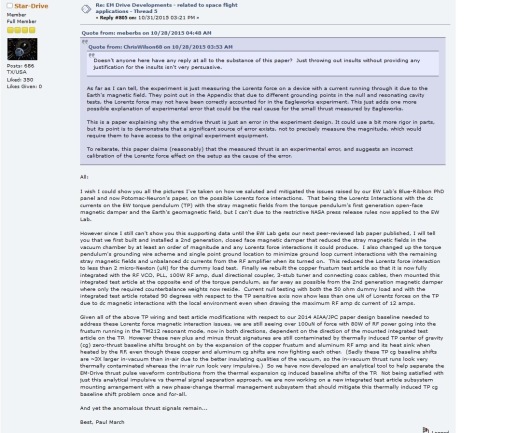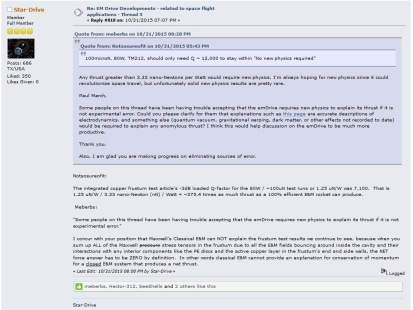There has been a lot of rumor on measurements performed by Eagleworks labs at NASA this spring. After that, NASA imposed a veto on whatever information should coming out about the work of this group until peer-reviewed work should have appeared. Most of the problems come out from the question of the EmDrive. This is a presumed thruster obtained by pumping radio-frequency into a cavity shaped as a closed frustum. This device has been largely dismissed by the physicists’ community due to a blatant violation of conservation of momentum. Such an object should stand still aside from known physical effects as Lorentz force or thermal thrust arising from heating of the cavity in the air. The claimed effect is really tiny standing on measurements that has been done since now and so, mundane explanations remain the most credited. Notwithstanding this, people at NASA have kept on working. This is testified by the recent posts by Paul March at Nasaspaceflight forum. Paul march is a member of the NASA group working on new propulsion technologies and what he is claiming is really striking. I report this here
 where he claims that, notwithstanding all the precautions, they keep on seeing a
where he claims that, notwithstanding all the precautions, they keep on seeing a thrust. They know perfectly that, for Maxwell theory, no thrust should be observed as stated by the following post
 So, they see a thrust, after having removed all mundane effects, and the possible explanation for it is not classical electromagnetism as all said from the start. In particular, it is cited by the questioner the link to Greg Egan’s post explaining why there cannot be any thrust by known electromagnetism with this geometry (see Greg Egan’s post). I think that they will make their results known once the peer-review process will be concluded. I would like to remember that other NASA labs asked to concur to confirm their measurements.
So, they see a thrust, after having removed all mundane effects, and the possible explanation for it is not classical electromagnetism as all said from the start. In particular, it is cited by the questioner the link to Greg Egan’s post explaining why there cannot be any thrust by known electromagnetism with this geometry (see Greg Egan’s post). I think that they will make their results known once the peer-review process will be concluded. I would like to remember that other NASA labs asked to concur to confirm their measurements.
This group also performed interference experiments on this cavity and observed an effect. If all this will be confirmed it will represent a breakthrough, not only from the technological side let me say, as a new physical effect will be proved at work with general relativity now to be experimentally managed on a tabletop device. Note that general relativity is always at work in this situation with a large density of electromagnetic energy as I also discussed here. It should be said that this has nothing to do with warp drive as conceived in Alcubierre metric and similar.
We hope to hear very soon from this group with more official channels. Surely, their results will provide a wealth of new avenues to pursue for research and technology.
Marco Frasca (2015). Einstein-Maxwell equations for asymmetric resonant cavities arXiv arXiv: 1505.06917v1


What about the variation of the dipoles on the borders of the cavity?
Dear Daniel,
Classical physics of this object is very well-known and can be easily reproduced with standard software. This is what all people working on it is currently doing. So, classically, it must stand still unless the energy density is large enough to produce a really tiny thrust due to the gravitational field as you can read from my paper. As far as I can tell, there seems to be no explanation to the large values of thrust they claim to measure from classical physics and a new effect should come into play. About this, there is a published paper by Fernando Minotti. Most of the scepticism about this matter arises from this.
Marco
But the case of dipoles is quantum mechanical. Not that is related to the quantization of gravity, but that the oscillations of such dipoles, which are discrete things.
Dear Marco,
On page 14 of your paper (http://arxiv.org/abs/1505.06917v1) you consider a frequency of
ν = 210.423537 GHz
instead of the frequency tested by NASA (which was 2 GHz, or 100 times smaller). Is this a typo on the paper? or otherwise, why consider a frequency that is 100 times higher than tested?
Jose’ Rodal, Ph.D.
Dear Jose’,
Nice to hear from you again. Thanks a lot for your interest about my work. The choice of that frequency was not aimed to any experiment around. What I did is to take one of the excitation frequencies of the cavity and put it into the equation. The greater the better to see if the effect was in the realm of observability. I am convinced that a part of the effect seen at EW is due to this but the rest is possibly in need of further explanation by more mundane effects.
Marco